Spatial–Temporal Pattern of Coordination between the Supply and Demand for Ecosystem Services in the Lhasa River Basin
Abstract
1. Introduction
2. Materials and Methods
2.1. Study Area
2.2. Data Sources and Descriptions
2.3. Quantification of Ecosystem Services Supply
2.4. Quantification of Ecosystem Services Demand
2.5. Supply–Demand Ratio of Ecosystem Service
2.6. Coupling Coordination Degree Model
2.7. Spatial Autocorrelation Analysis
3. Results
3.1. Spatial and Temporal Pattern of Ecosystem Service Supply and Demand
3.2. Coordination Pattern and Evolution Features of the Supply and Demand Coupling of Ecosystem Services
3.3. Spatial Autocorrelation of Ecosystem Service Supply–Demand Pattern
4. Discussion
4.1. Dynamic Analysis of Supply–Demand Coupling of Ecosystem Services
4.2. Implications of Ecosystem Services Supply–Demand Contradiction
5. Conclusions
Supplementary Materials
Author Contributions
Funding
Data Availability Statement
Acknowledgments
Conflicts of Interest
References
- Costanza, R.; d’Arge, R.; de Groot, R.; Farber, S.; Grasso, M.; Hannon, B.; Limburg, K.; Naeem, S.; O’Neill, R.V.; Paruelo, J.; et al. The value of the world’s ecosystem services and natural capital. Nature 1997, 387, 253–260. [Google Scholar] [CrossRef]
- Ouyang, Z.; Zhu, C.; Yang, G.; Xu, W.; Zheng, H.; Zhang, Y.; Xiao, Y. Gross ecosystem product: Concept, accounting framework and case study. Acta Ecol. Sin. 2013, 33, 6747–6761. [Google Scholar] [CrossRef]
- Arowolo, A.O.; Deng, X.; Olatunji, O.A.; Obayelu, A.E. Assessing Changes in the Value of Ecosystem Services in Response to Land-Use/Land-Cover Dynamics in Nigeria. Sci. Total Environ. 2018, 636, 597–609. [Google Scholar] [CrossRef] [PubMed]
- Cerretelli, S.; Poggio, L.; Gimona, A.; Yakob, G.; Boke, S.; Habte, M.; Coull, M.; Peressotti, A.; Black, H. Spatial Assessment of Land Degradation through Key Ecosystem Services: The Role of Globally Available Data. Sci. Total Environ. 2018, 628–629, 539–555. [Google Scholar] [CrossRef] [PubMed]
- Liu, H.; Xing, L.; Wang, C.; Zhang, H. Sustainability Assessment of Coupled Human and Natural Systems from the Perspective of the Supply and Demand of Ecosystem Services. Front. Earth Sci. 2022, 10, 1025787. [Google Scholar] [CrossRef]
- Ming, L.; Chang, J.; Li, C.; Chen, Y.; Li, C. Spatial-Temporal Patterns of Ecosystem Services Supply-Demand and Influencing Factors: A Case Study of Resource-Based Cities in the Yellow River Basin, China. Int. J. Environ. Res. Public Health 2022, 19, 16100. [Google Scholar] [CrossRef] [PubMed]
- Huang, C.; Zeng, J.; Chen, W.; Cui, X. Spatiotemporal Characteristics of the Coupled Coordination Degree of Ecosystem Services Supply and Demand in Chinese National Nature Reserves. Int. J. Environ. Res. Public Health 2023, 20, 4845. [Google Scholar] [CrossRef] [PubMed]
- Zhang, X.; Liu, Y.; Wang, Y.; Yuan, X. Interactive Relationship and Zoning Management between County Urbanization and Ecosystem Services in the Loess Plateau. Ecol. Indic. 2023, 156, 111021. [Google Scholar] [CrossRef]
- Zhao, W.; Liu, Y.; Daryanto, S.; Fu, B.; Wang, S.; Liu, Y. Metacoupling Supply and Demand for Soil Conservation Service. Curr. Opin. Environ. Sustain. 2018, 33, 136–141. [Google Scholar] [CrossRef]
- Wang, X.; Jia, Z.; Feng, X.; Ma, J.; Zhang, X.; Zhou, J.; Fu, X. Analysis on supply and demand balance of soil conservation service and its driving factors on the Loess Plateau. Acta Ecol. Sin. 2023, 43, 2722–2733. [Google Scholar] [CrossRef]
- Chen, X.; Li, F.; Li, X.; Hu, Y.; Hu, P. Evaluating and Mapping Water Supply and Demand for Sustainable Urban Ecosystem Management in Shenzhen, China. J. Clean. Prod. 2020, 251, 119754. [Google Scholar] [CrossRef]
- Meng, S.; Huang, Q.; Zhang, L.; He, C.; Inostroza, L.; Bai, Y.; Yin, D. Matches and Mismatches between the Supply of and Demand for Cultural Ecosystem Services in Rapidly Urbanizing Watersheds: A Case Study in the Guanting Reservoir Basin, China. Ecosyst. Serv. 2020, 45, 101156. [Google Scholar] [CrossRef]
- Yoshimura, N.; Hiura, T. Demand and Supply of Cultural Ecosystem Services: Use of Geotagged Photos to Map the Aesthetic Value of Landscapes in Hokkaido. Ecosyst. Serv. 2017, 24, 68–78. [Google Scholar] [CrossRef]
- Li, F.; Sun, R.; Yang, L.; Chen, L. Assessment of fresh water ecosystem services in Beijing based on demand and supply. Chin. J. Appl. Ecol. 2010, 21, 1146–1152. [Google Scholar] [CrossRef]
- Liu, G.; Zhang, L.; Zhang, Q. Spatial and temporal dynamics of land use and its influence on ecosystem service value in Yangtze River Delta. Acta Ecol. Sin. 2014, 34, 3311–3319. [Google Scholar]
- Peng, J.; Yang, Y.; Xie, P.; Liu, Y. Zoning for the construction of green space ecological networks in Guangdong Province based on the supply and demand of ecosystem services. Acta Ecol. Sin. 2017, 37, 4562–4572. [Google Scholar]
- Jing, Y.; Chen, L.; Sun, R. A theoretical research framework for ecological security pattern construction based on ecosystem services supply and demand. Acta Ecol. Sin. 2018, 38, 4121–4131. [Google Scholar]
- Yang, D.; Zhu, C.; Li, J.; Li, Y.; Zhang, X.; Yang, C.; Chu, S. Exploring the Supply and Demand Imbalance of Carbon and Carbon-Related Ecosystem Services for Dual-carbon Goal Ecological Management in the Huaihe River Ecological Economic Belt. Sci. Total Environ. 2024, 912, 169169. [Google Scholar] [CrossRef]
- Lu, H.; Stringer Lindsay, C.; Yan, Y.; Wang, C.; Zhao, C.; Rong, Y.; Zhu, J.; Wu, G.; Martin, D. Mapping ecosystem service supply and demand: Historical changes and projectionsunder SSP-RCP scenarios. Acta Ecol. Sin. 2023, 43, 1309–1325. [Google Scholar]
- Zhang, P.; Zhu, X.; He, Q.; Ouyang, X. Spatial-temporal differentiation and balance pattern of supply and demand of ecosystem services of the Yangtze River Economic Zone. Ecol. Sci. 2020, 39, 155–166. [Google Scholar] [CrossRef]
- Hou, L.; Wu, F.; Xie, X. The Spatial Characteristics and Relationships Between Landscape Pattern and Ecosystem Service Value along an Urban-Rural Gradient in Xi’an City, China. Ecol. Indic. 2020, 108, 105720. [Google Scholar] [CrossRef]
- Xu, L.; Yang, D.; Liu, D.; Lin, H. Spatiotemporal Distribution Characteristics and Supply-Demand Relationships of Ecosystem Services on the Qinghai-Tibet Plateau, China. Mt. Res. 2020, 38, 483–494. [Google Scholar] [CrossRef]
- Zheng, B.; Xu, Q.; Shen, Y. The Relationship Between Climate Change and Quaternary Glacial Cycles on the Qinghai-Tibetan Plateau: Review and Speculation. Quaternary 2002, 97–98, 93–101. [Google Scholar] [CrossRef]
- Zhang, S.; Wu, T.; Guo, L.; Zhao, Y. Assessing Ecological Risk on the Qinghai-Tibet Plateau Based on Future Land Use Scenarios and Ecosystem Service Values. Ecol. Indic. 2023, 154, 110769. [Google Scholar] [CrossRef]
- Shi, W.; Qiao, F.; Zhou, L. Identification of Ecological Risk Zoning on Qinghai-Tibet Plateau from the Perspective of Ecosystem Service Supply and Demand. Sustainability 2021, 13, 5366. [Google Scholar] [CrossRef]
- Han, W.; Su, X.; Lu, H.; Li, T.; Jin, T.; Zhang, M.; Liu, G. Impacts of Human Activity Intensity on Ecosystem Services for Conservation in the Lhasa River Basin. Ecosyst. Health Sustain. 2023, 9, 0088. [Google Scholar] [CrossRef]
- An, B.; Yao, T.; Guo, Y.; Wang, W.; Li, J.; Li, X.; Wang, Z. Protection, Restoration, and Governance Technology Demonstration System in the Typical Regions of the Lhasa River Basin. Chin. J. 2021, 66, 2775–2784. [Google Scholar] [CrossRef]
- Huang, L.; He, C.; Wang, B. Study on the Spatial Changes Concerning Ecosystem Services Value in Lhasa River Basin, China. Environ. Sci. Pollut. Res. 2022, 29, 7827–7843. [Google Scholar] [CrossRef] [PubMed]
- Shui, Y.; Lu, H.; Wang, F.; Yan, Y.; Wu, G. Assessment of habitat quality on the basis of land cover and NDVI changes in Lhasa River Basin. Acta Ecol. Sin. 2018, 38, 8946–8954. [Google Scholar]
- Zhang, S.; Lei, Y.; Yao, Q.; Li, H. Runoff Response to Land Cover and Climate Change in Lhasa River Basin. Water Resour. Prot. 2010, 26, 39–44. [Google Scholar]
- Lu, H.; Huang, Q.; Zhu, J.; Zheng, T.; Yan, Y.; Wu, G. Ecosystem Type and Quality Changes in Lhasa River Basin and Their Effects on Ecosystem Services. Acta Ecol. Sin. 2018, 38, 8911–8918. [Google Scholar]
- Liang, Y.; Song, W. Integrating Potential Ecosystem Services Losses into Ecological Risk Assessment of Land Use Changes: A Case Study on the Qinghai-Tibet Plateau. J. Environ. Manag. 2022, 318, 115607. [Google Scholar] [CrossRef] [PubMed]
- Ouyang, Z.; Zheng, H.; Xiao, Y.; Polasky, S.; Liu, J.; Xu, W.; Wang, Q.; Zhang, L.; Xiao, Y.; Rao, E.; et al. Improvements in Ecosystem Services from Investments in Natural Capital. Science 2016, 352, 1455–1459. [Google Scholar] [CrossRef] [PubMed]
- Sharp, R.; Tallis, H.; Ricketts, T.; Guerry, A.; Wood, S.; Chaplin-Kramer, R.; Nelson, E.; Ennaanay, D.; Wolny, S.; Olwero, N. InVEST 3.6. 0 User’s Guide; Collaborative Publication by the Natural Capital Project, Stanford University, The University of Minnesota, The Nature Con-servancy, and World Wildlife Fund; Stanford University: Stanford, CA, USA, 2018. [Google Scholar]
- Li, P.; Liu, C.; Liu, L.; Wang, W. Dynamic Analysis of Supply and Demand Coupling of Ecosystem Services in Loess Hilly Region: A Case Study of Lanzhou, China. Chin. Geogr. Sci. 2021, 31, 276–296. [Google Scholar] [CrossRef]
- Liu, Y.; Zhao, M. Linking Ecosystem Service Supply and Demand to Landscape Ecological Risk for Adaptive Management: The Qinghai-Tibet Plateau Case. Ecol. Indic. 2023, 146, 109796. [Google Scholar] [CrossRef]
- Burkhard, B.; Kroll, F.; Nedkov, S.; Müller, F. Mapping Ecosystem Service Supply, Demand and Budgets. Ecol. Indic. 2012, 21, 17–29. [Google Scholar] [CrossRef]
- Wolff, S.; Schulp, C.J.E.; Verburg, P.H. Mapping Ecosystem Services Demand: A Review of Current Research and Future Perspectives. Ecol. Indic. 2015, 55, 159–171. [Google Scholar] [CrossRef]
- Wang, C.; Wu, X.; Fu, B.; Han, X.; Chen, Y.; Wang, K.; Zhou, H.; Feng, X.; Li, Z. Ecological Restoration in the Key Ecologically Vulnerable Regions: Current Situation and Development Direction. Acta Ecol. Sin. 2019, 39, 7333–7343. [Google Scholar]
- Liu, C.; Yang, M.; Hou, Y.; Xue, X. Ecosystem Service Multifunctionality Assessment and Coupling Coordination Analysis with Land Use and Land Cover Change in China’s Coastal Zones. Sci. Total Environ 2021, 797, 149033. [Google Scholar] [CrossRef]
- Xu, Q.; Yang, R.; Zhuang, D.; Lu, Z. Spatial Gradient Differences of Ecosystem Services Supply and Demand in the Pearl River Delta Region. J. Clean. Prod. 2021, 279, 123849. [Google Scholar] [CrossRef]
- Li, Y.; Li, Y.; Zhou, Y.; Shi, Y.; Zhu, X. Investigation of a Coupling Model of Coordination between Urbanization and the Environment. J. Environ. 2012, 98, 127–133. [Google Scholar] [CrossRef] [PubMed]
- Yu, J.; Yi, L.; Xie, B.; Li, X.; Li, J.; Xiao, J.; Zhang, L. Matching and Coupling Coordination between the Supply and Demand for Ecosystem Services in Hunan Province, China. Ecol. Indic. 2023, 157, 111303. [Google Scholar] [CrossRef]
- Zhang, S.; Wu, T.; Guo, L.; Zou, H.; Shi, Y. Integrating Ecosystem Services Supply and Demand on the Qinghai-Tibetan Plateau Using Scarcity Value Assessment. Ecol. Indic. 2023, 147, 109969. [Google Scholar] [CrossRef]
- Naimi, B.; Hamm, N.A.S.; Groen, T.A.; Skidmore, A.K.; Toxopeus, A.G.; Alibakhshi, S. ELSA: Entropy-Based Local Indicator of Spatial Association. Spat. Stat. 2019, 29, 66–88. [Google Scholar] [CrossRef]
- Anselin, L. Local Indicators of Spatial Association-LISA. Geogr. Anal. 1995, 27, 93–115. [Google Scholar] [CrossRef]
- Lu, H.; Yan, Y.; Zhu, J.; Jin, T.; Liu, G.; Wu, G.; Stringer, L.C.; Dallimer, M. Spatiotemporal Water Yield Variations and Influencing Factors in the Lhasa River Basin, Tibetan Plateau. Water 2020, 12, 1498. [Google Scholar] [CrossRef]
- Chen, T.; Jiao, J.; Chen, Y.; Lin, H.; Wang, H.; Bai, L. Distribution and Land Use Characteristics of Alluvial Fans in the Lhasa River Basin, Tibet. J. Geogr. Sci. 2021, 31, 1437–1452. [Google Scholar] [CrossRef]
- Li, D.; Tian, P.; Shao, D.; Hu, T.; Luo, H.; Dong, B.; Khan, S.; Cui, Y.; Luo, Y. Assessment of Water Pollution in the Tibetan Plateau with Contributions from Agricultural and Economic Sectors: A Case Study of Lhasa River Basin. Environ. Sci. Pollut. Res. 2022, 29, 20617–20631. [Google Scholar] [CrossRef]
- Wang, H.; Wang, L.; Fu, X.; Yang, Q.; Wu, G.; Guo, M.; Zhang, S.; Wu, D.; Zhu, Y.; Deng, H. Spatial-Temporal Pattern of Ecosystem Service Supply-Demand and Coordination in the Ulansuhai Basin, China. Ecol. Indic. 2022, 143, 109406. [Google Scholar] [CrossRef]
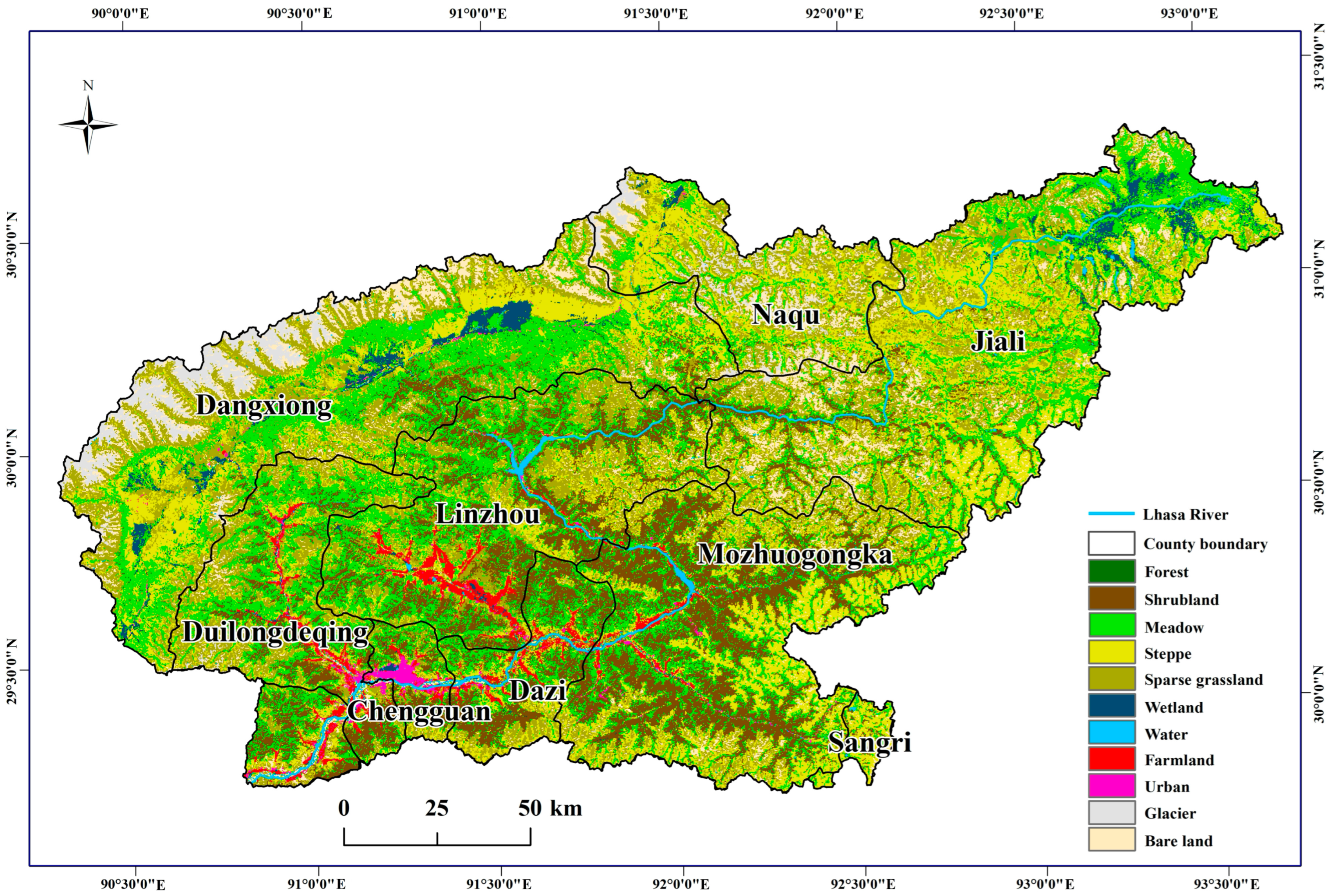
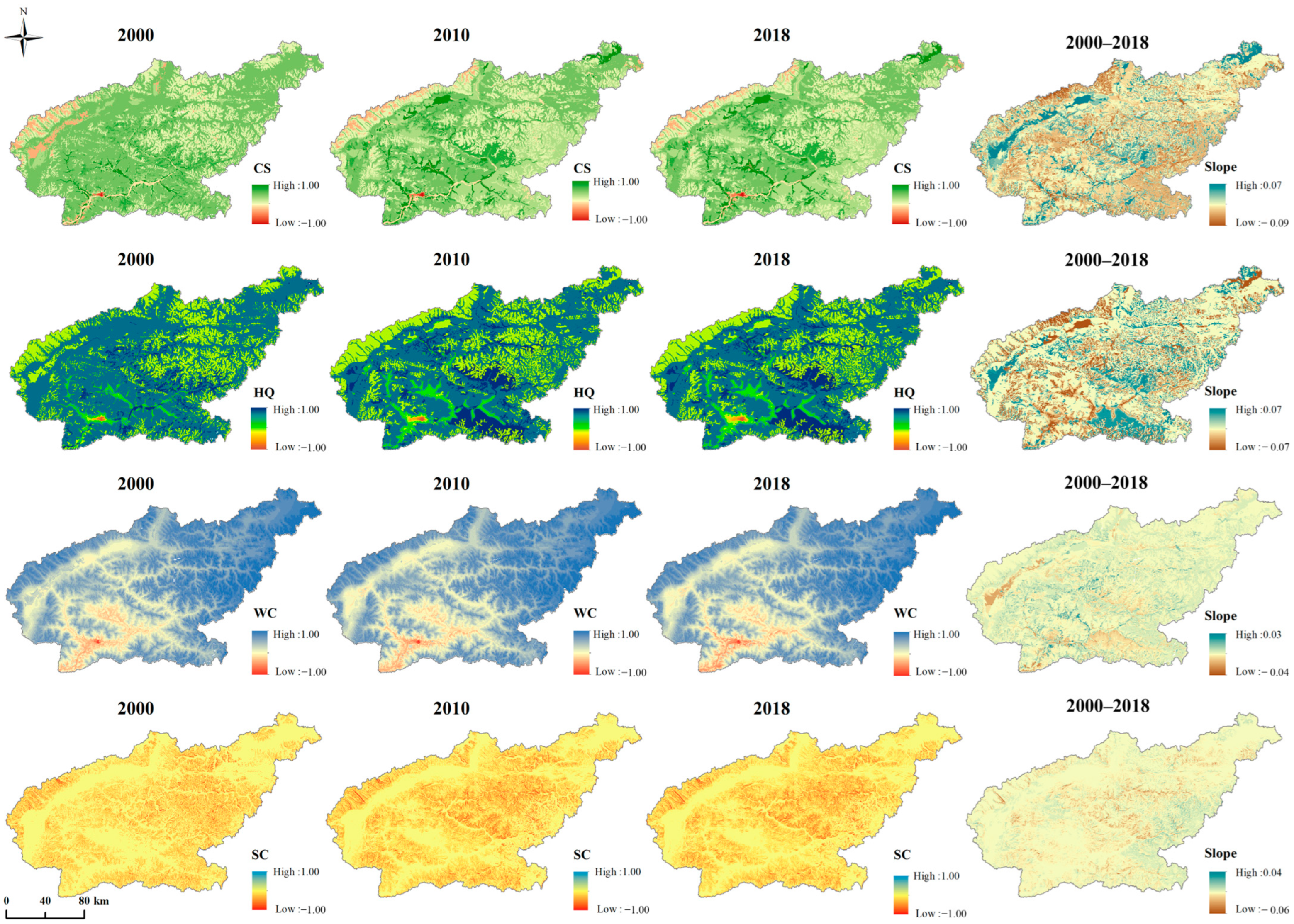
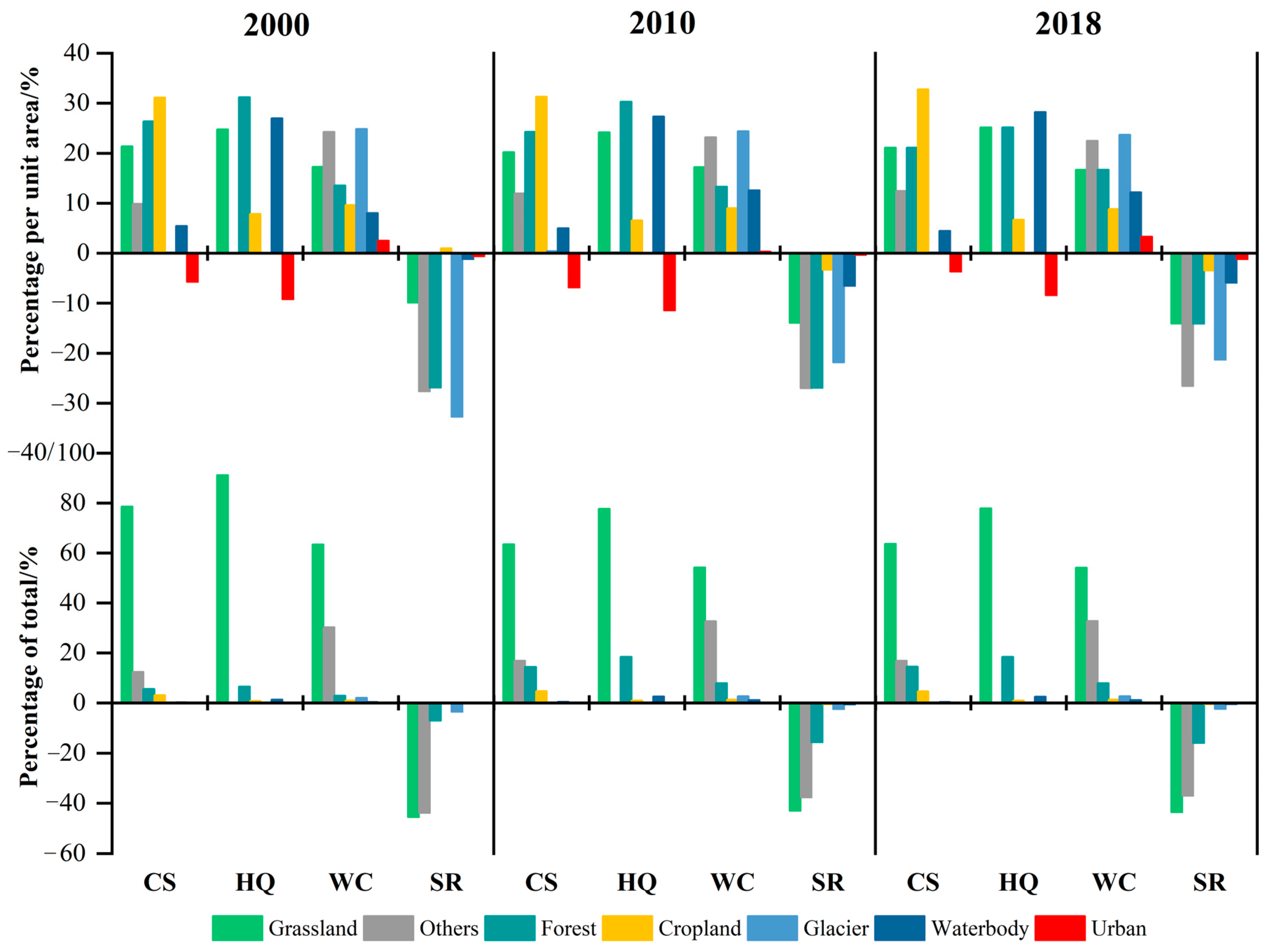
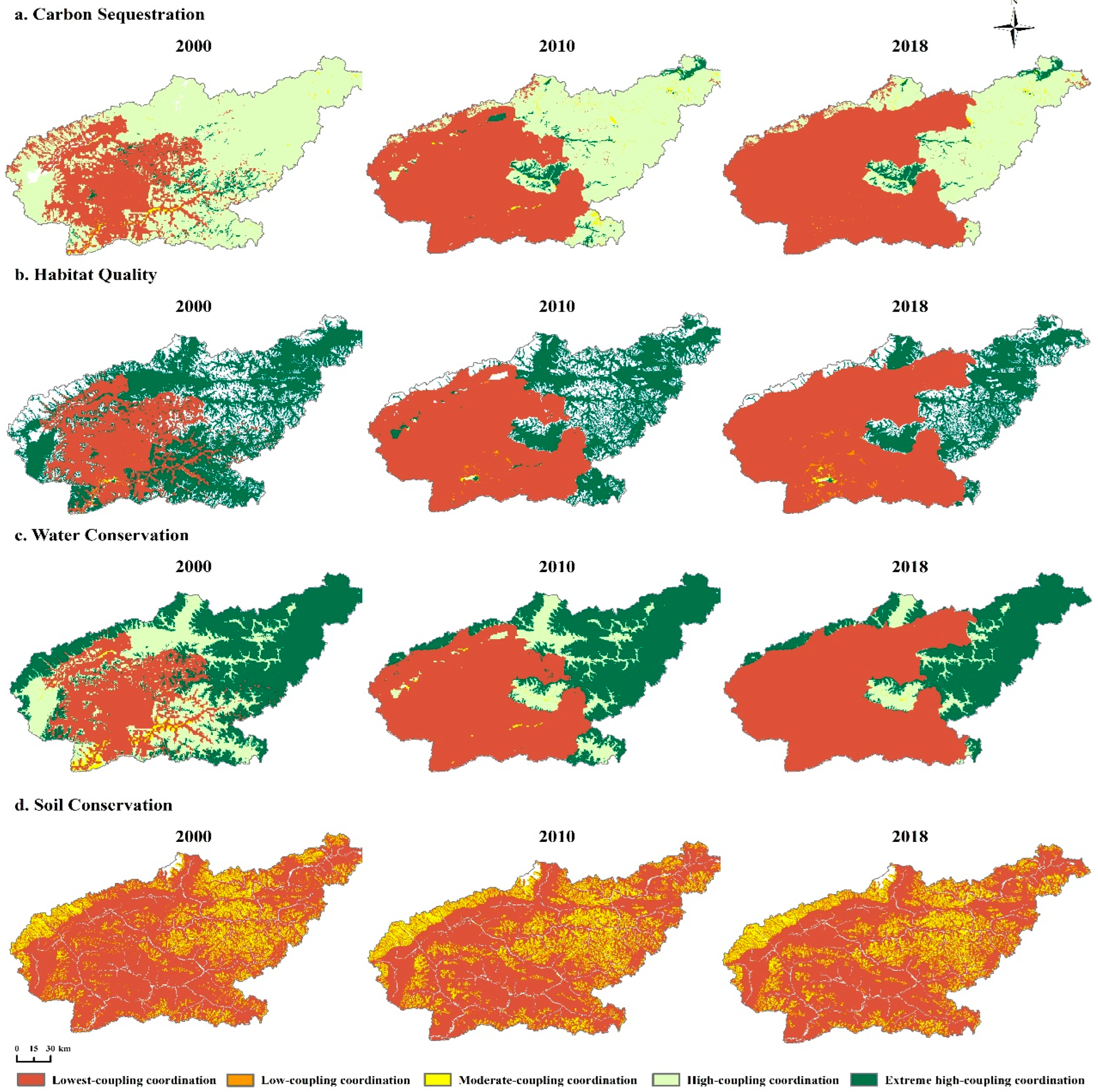

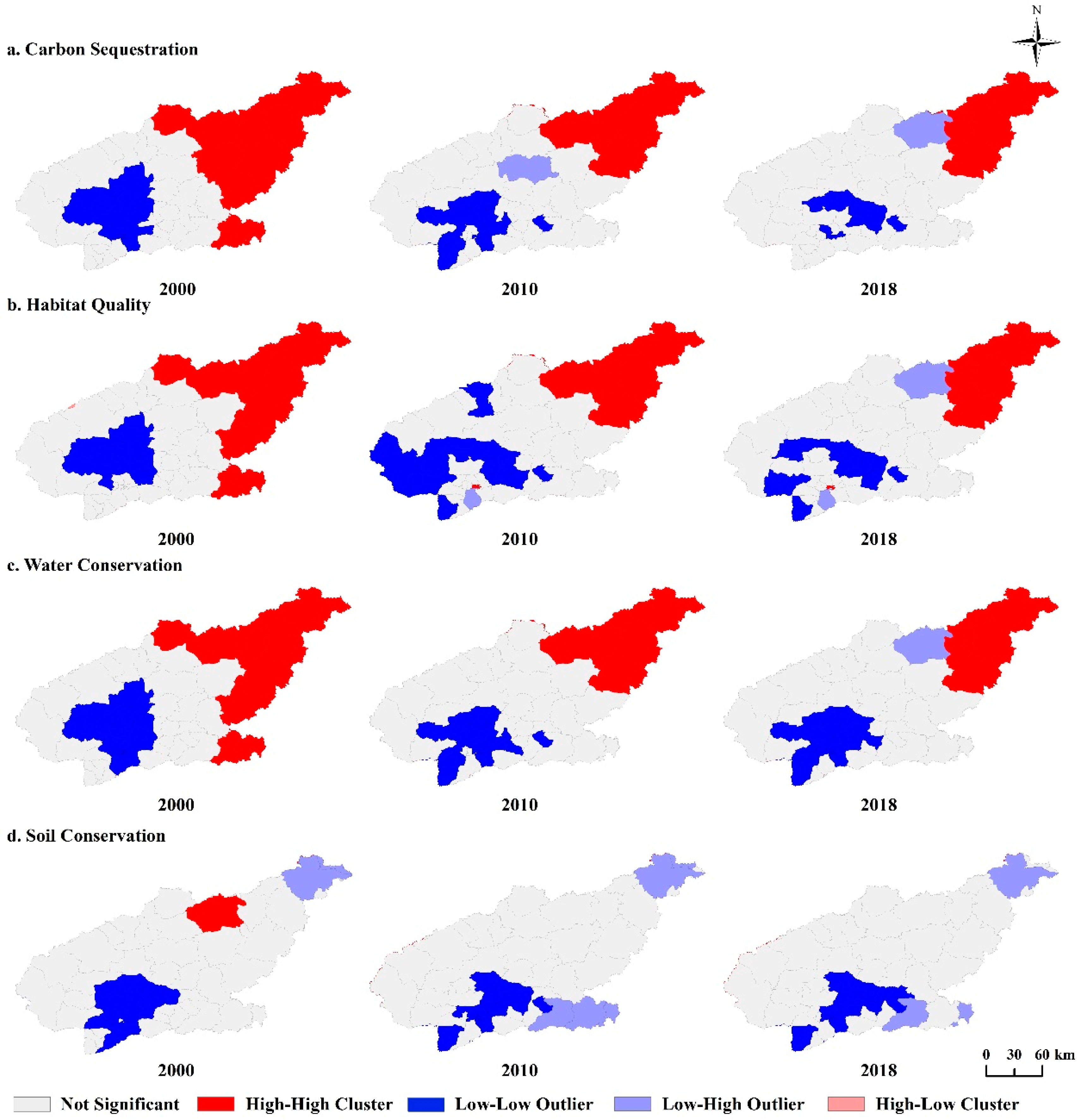
| Data | Resolution | Time Period |
|---|---|---|
| Land use data | 250 m | 2000, 2010, 2018 |
| Ecosystem type data | 90 m | 2015 |
| Digital elevation model (DEM) | 30 m | 2009 |
| Soil map and attribute data | 1 km | 2012 |
| Meteorological data (temperature and precipitation) | 1 km | 1980–2018 |
| Evapotranspiration data | 500 m | 2000–2018 |
| Social and economic data | 1 km | 2000, 2010, 2018 |
| Range of CCD Values | Type | Range of CCD Values |
|---|---|---|
| 0 ≤ CCD ≤ 0.1 | Lowest coupling coordination | 0 ≤ CCD ≤ 0.1 |
| 0.1 < CCD < 0.2 | Low coupling coordination | 0.1 < CCD < 0.2 |
| 0.2 < CCD < 0.5 | Moderate coupling coordination | 0.2 < CCD < 0.5 |
| 0.5 < CCD < 0.8 | High coupling coordination | 0.5 < CCD < 0.8 |
| 0.8 < CCD < 1 | Extremely high coupling coordination | 0.8 < CCD < 1 |
Disclaimer/Publisher’s Note: The statements, opinions and data contained in all publications are solely those of the individual author(s) and contributor(s) and not of MDPI and/or the editor(s). MDPI and/or the editor(s) disclaim responsibility for any injury to people or property resulting from any ideas, methods, instructions or products referred to in the content. |
© 2024 by the authors. Licensee MDPI, Basel, Switzerland. This article is an open access article distributed under the terms and conditions of the Creative Commons Attribution (CC BY) license (https://creativecommons.org/licenses/by/4.0/).
Share and Cite
Liu, J.; Wan, J.; Li, S.; Shen, Y.; Han, W.; Liu, G. Spatial–Temporal Pattern of Coordination between the Supply and Demand for Ecosystem Services in the Lhasa River Basin. Land 2024, 13, 510. https://doi.org/10.3390/land13040510
Liu J, Wan J, Li S, Shen Y, Han W, Liu G. Spatial–Temporal Pattern of Coordination between the Supply and Demand for Ecosystem Services in the Lhasa River Basin. Land. 2024; 13(4):510. https://doi.org/10.3390/land13040510
Chicago/Turabian StyleLiu, Jingyang, Jia Wan, Shirong Li, Yuzhe Shen, Wangya Han, and Guohua Liu. 2024. "Spatial–Temporal Pattern of Coordination between the Supply and Demand for Ecosystem Services in the Lhasa River Basin" Land 13, no. 4: 510. https://doi.org/10.3390/land13040510
APA StyleLiu, J., Wan, J., Li, S., Shen, Y., Han, W., & Liu, G. (2024). Spatial–Temporal Pattern of Coordination between the Supply and Demand for Ecosystem Services in the Lhasa River Basin. Land, 13(4), 510. https://doi.org/10.3390/land13040510






